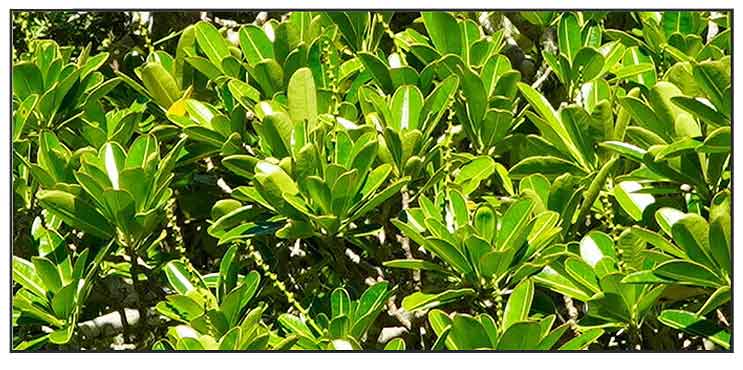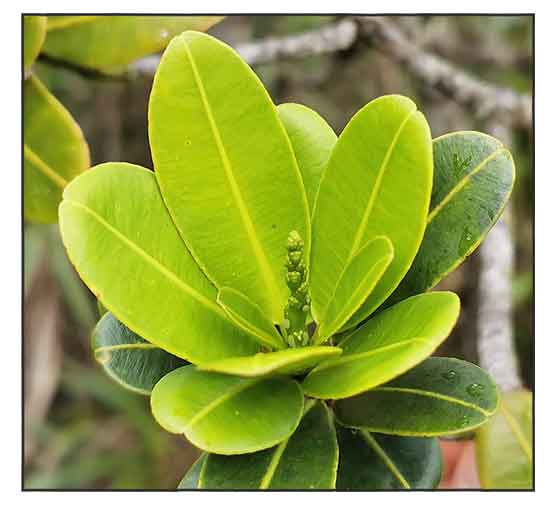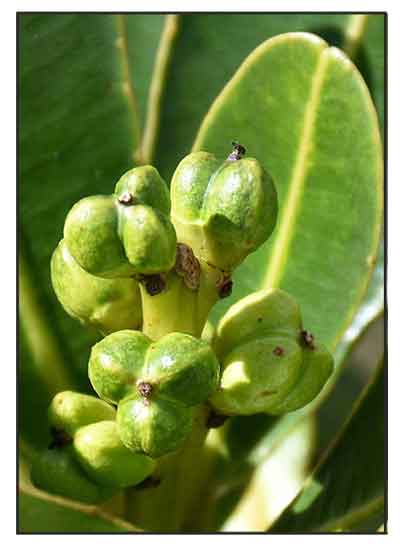 Gen info Gen info
- Stillingea is a plant genus of the family Euphorbiaceae, first described as a genus in 1767. Toothleaf is a common name for plants in the genus.
-
Stillingia lineata is a species of flowering plant in the family Euphorbiaceae. It was orginally described by Jean-Baptiste Lamarck as Sapium lineatum in 1788 and moved to genus Stillingia in 1866. (3)
- Etymology: The genus name Stillingia honors Benjamin Stillingfleet, an 18th-century English naturalist known for his work on botany and natural history. The specific epithet lineata derives from Latin lineatus, meaning "marked with lines" or "striped", referring to the distinct veining patters of the leaves.
 Botany Botany
• Monoecious shrub or small tree up to 12 m tall; bark smooth, covered with leaf-scars. Leaves alternate, simple, crowded at apex of branches; stipules 1–1.5 mm long, deeply split, soon falling; petiole 3–17 mm long, without glands or with a pair of glands on the junction with the blade; blade orbicular to elliptical, (4–)7–24 cm × 2–4 cm, base cuneate to obtuse, apex acute to rounded to reuse, margin entire or toothed with teeth 2–3(–4) mm apart, membranous or slightly succulent. Inflorescence a terminal spike 2–13 cm long, lower part with up to 12 solitary female flowers, terminal part with male flowers in clusters of up to 15 flowers; bracts minute. Flowers uni sexual, nearly sessile; pedicure minute; male flowers with tubular panther with 2 lobes or horns, 1 mm long, stamens 2, filaments c. 1 mm long; female flowers with 3-lobed panther, ovary superior, ovoid, 3-celled, styles 3. Fruit a 3-lobed capsule 5–6 mm × 7–8 mm, notched, dehiscing explosively, remaining thickened, 3-lobed stalk up to 8 mm in diameter. Seeds oblong, 4–5 mm × 3–3.5 mm, gray when dry, pitted, with caruncle. Seedling with epigeal germination. (PROTA) (13)
• Two subspecies are distinguished In Stillingia lineata. Subspecies from Mauritius and Réunion has firm to slightly succulent, entire leaves with scarcely visible venation and no marginal glands. Asian plants are distinguishable by thin leaves with obvious serration, venation, and glands. (13)
Distribution
- Native to the Philippines. (1) (2)
- In Dalupiri, Mindoro.
- In Malesia only known from coastal forest and coconut plantation on coral soil, but poorly known. (1)
- Also native to Fiji, Lesser Sunda Is., Maluku, Mauritius, Réunion, South China Sea. (2)
- On beaches and forests up to 300 m altitude.
Constituents
- The leaves and stems contain phenols, tannins, coumarins, terpenes, saponins, and alkaloids. (13)
-
Phytochemical study of ethyl acetate extract of Stillingia lineata ssp. lineata tonantzitlolone A and B (1 and 2), together with the new 4'-hydroxytonantzitolone, named tonantzitolone C (3) and new ent-12α-hydroxy-3,7-dioxoisopimara-815-diene (4).
(see study below) (6)
- LC/MS and bioassay guided purification of EtOAc leaf extract isolated six new (-9) and three known (1-3) tonantzitlolones, along with tonantzitloic acid (10), a new linear diterpenoid, and three new (11,13, 15) and two known (12, 14) tigliane-ty[e diterpenoids.
(see study below) (10)
 Properties Properties
- Toxicity concern: Leaves are reportedly toxic and stupefying.
-
Studies have suggested antiviral, α-glucosidase inhibitory, anti-chikungunya properties.
Parts used
Stem bark.
Uses
Edibility
- No reports found on edibility.
Folkloric
- No reported folkloric medicinal use in the Philippines.
-
Bathing using decoction of whole plant used for treatment of eczema. (7)
- In Reunion Island, used for treatment of chikungunya virus and furuncles. (11) In the Mascarene Islands, used for treatment of eczema and skin disease. (12)
Studies
• Tonantzitlolones / Antiviral / Potential Chikyngunya Virus Inhibitor: Study evaluated S. lineata for antiviral (chikungunya) potential. Phytochemical extraction isolated tonantzitlolone A and B (1 and 2), together with the new 4'-hydroxytonantzitolone, named tonantzitolone C (3) and new ent-12α-hydroxy-3,7-dioxoisopimara-815-diene (4). The entire ethyl acetate extract of stem bark exhibited selective antiviral activity against the chikyngunya virus with EC50 <0.8 µg/mL, with only weak cytotoxic effect on host cells. Subsequent evaluation for inhibition of chikungunya virus replication in cellulo demonstrated that 4'-acetoxytonontzitlolone as antiviral activity against CHIKCV. (see constituents above) (6)
• Anti-Chikungunya Virus / Anti-HIV: In a review of major databases on the antiviral propensities of Mascarene endemic and indigenous medicinal plants, Stillingia lineata was the most effective against chikungunya virus (SI: 10.9). Among its isolated compounds12-O-acetylphorbol-13(2″-methyl)- butyrate and 12-deoxyphorbol- 13(2″-methyl)butyrate were the most potent and selective inhibitors of chikungunya virus replications (SI: 41 and >240, respectively). 12-O-acetylphorbol-13(2″-methyl)- butyrate, 12β-O-[nona- 2Z,4E,6E-trienoyl]-4α-deoxyphorbol-13-butyrate, 12-deoxyphorbol-13(2″-methyl)butyrate, and 12-deoxyphorbol-13-[8'-oxohexadeca-2E,4E,6E-trienoate showed strong selective antiviral effect on human immunodeficiency virus-I (SI: 36-899) and II (SI: 33-2056). (8)
• α-Glucosidase Inhibitory Property: In a study of 5 traditionally used antidiabetic native medicinal plants of Maritius for possible α-amylase and α-glucosidase inhibitory properties, Stillingia lineata was one of four found to significantly (p<0.05) inhibit α-glucosidase (between 87.41 and 06.87% inhibition). In study for glucose entrapment capacity, was more active with 29% GDRI (glucose diffusion retardation index). (9)
• Antiviral / Flexibilane and Tigliane Diterpenoids / Leaves: Study evaluated S. lineata for potent and selective inhibitors of chikungunya virus and HIV1 and HIV2 replicators. LC/MS and bioassay guided purification of EtOAc leaf extract isolated six new (-9) and three known (1-3) tonantzitlolones, along with tonantzitloic acid (10), a new linear diterpenoid, and three new (11,13, 15) and two known (12, 14) tigliane-ty[e diterpenoids. Compounds 12-15 were found to be the most potent and selective inhibitors of CHIKV, HIV1 and HIV2 replication. Compound 14 inhibited CHIKV replication with EC50 of 1.2 µM and selectivity index >240, while compound 15 inhibited HIV1 and HIV2 with EC50s of 0.043 and 0.018 µM, respectively. (10)
• Antioxidant / Phenolic Content / Leaves: Study evaluated a leaf extract for phenolic content and antioxidant potential. Results showed total phenolics of 97.7 ± 3.36 mg GAE/g; total flavonoids 6.61 ± 0.19 mg QE/g; total proanthocyanidins ND. Antioxidant assays revealed FRAP 4.53 ± 0.02 mmol Fe2+; iron chelating activity 6.5 ± 0.02 mg/ml; DPPH radical scavenging activity 4.04 ± 0.17 µg/ml; superoxide scavenging activity 3.81 ± 0.48 µg/ml; nitric oxide scavenging activity 68.5 µg/ml. (12)
Availability
- Wild-crafted.
|

![]()






